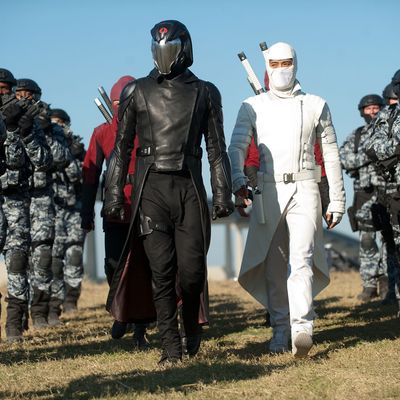
An admission: I’m one of that small, proud handful of jerks who actually liked the first G.I. Joe movie, which, despite being widely loathed, was just enough of a hit that now they’ve made another one. At the time, The Rise of Cobra seemed like the kind of elaborate, ridiculous, and shallow entertainment that a child playing with his action figures might have dreamt up, and for a couple of hours, I was that child. In fact, if you’d told me the first film was the result of some time warp in which my 11-year-old self accidentally gained access to a CGI workstation, I might have even believed it. No Transformers-ian bloat or Pirates of the Caribbean–esque tedium; just pure, goofy, stoopid fun.
There’s been a bit of rethinking and re-tinkering and rebooting with the sequel, G.I. Joe: Retaliation — sometimes for the better but often for the worse. The plot itself makes the reboot explicit. While disarming a Pakistani nuclear facility, the G.I. Joes fall into a trap and are wiped out. (Among the fallen is the previous film’s hero, Duke, played by Channing Tatum.) Only three survive: Roadblock (Dwayne “The Rock” Johnson), Lady Jaye (Adrianne Palicki), and Flint (D.J. Cotrona), along with silent, masked Ninja ace Snake Eyes (Ray Park), who’s taken a leave of absence or something but soon enough re-joins the team. Apparently, the U.S. president (Jonathan Pryce) has been replaced with an impostor, Cobra’s master of disguise Zartan (Arnold Vosloo, seen rarely, even though his character has tons of screen time). He and the rest of Cobra have an evil plan to force the entire world to disarm their nuclear weapons so that the nefarious organization’s latest superweapon can reign supreme. Oddly, Pryce and the Impostor President concept are holdovers from the previous film’s ending, but if you try to figure out how the timing between the two movies works, given what appears to have happened in the meantime, your brain might turn into that stuff Gwyneth Paltrow eats.
The action this time around is a mixed bag. Director Stephen Sommers’s cartoonish action scenes had a kind of devil-may-care bravado in the first film. Sommers (who also did the Mummy movies) has been replaced here by Jon M. Chu, heretofore known primarily as the guy who gave a couple of the Step Up movies (the second and third, specifically) their own brand of surreal vigor. Oddly enough, that hasn’t led to something more distinctive or compelling. The new film has less of that toys-being-knocked-around quality. This time, the action has more heft, more — dare I say it? — realism. But is that what a G.I. Joe movie needs? Gone is that sense of cartoonish fun, replaced by a curious, competent anonymity. We could easily just be watching outtakes from The Expendables or The A-Team or The Losers.
That’s not entirely true. We still have Snake Eyes and his ongoing psychodrama with white-clad Ninja villain Storm Shadow (Byung-hun Lee), which results in the film’s best scene, an eye-popping and electrifying action set piece at the mysterious Ninja Mountain, a remote retreat in the Himalayas. Watching a small army of Ninjas rappelling and zip-lining and bungee jumping as they fight across a mountain range, you may find yourself remembering why such movies exist in the first place. (You may also find yourself anticipating the inevitable Snake Eyes/Storm Shadow spinoff that will surely come down the pike after this new movie makes a gazillion dollars.) But that amazing sequence in turn serves to remind you how corporate the rest of the movie often feels. That G.I. Joe silliness the first film embraced has been steamrolled into tentpole flatness this time around. It’s not stoopid anymore, but just plain stupid.


